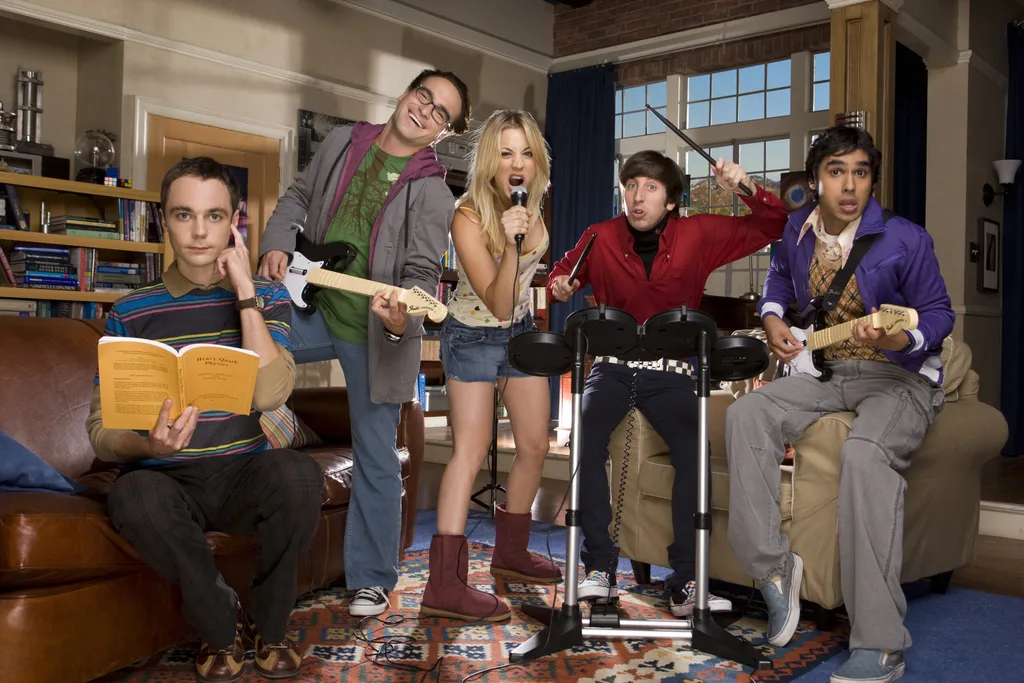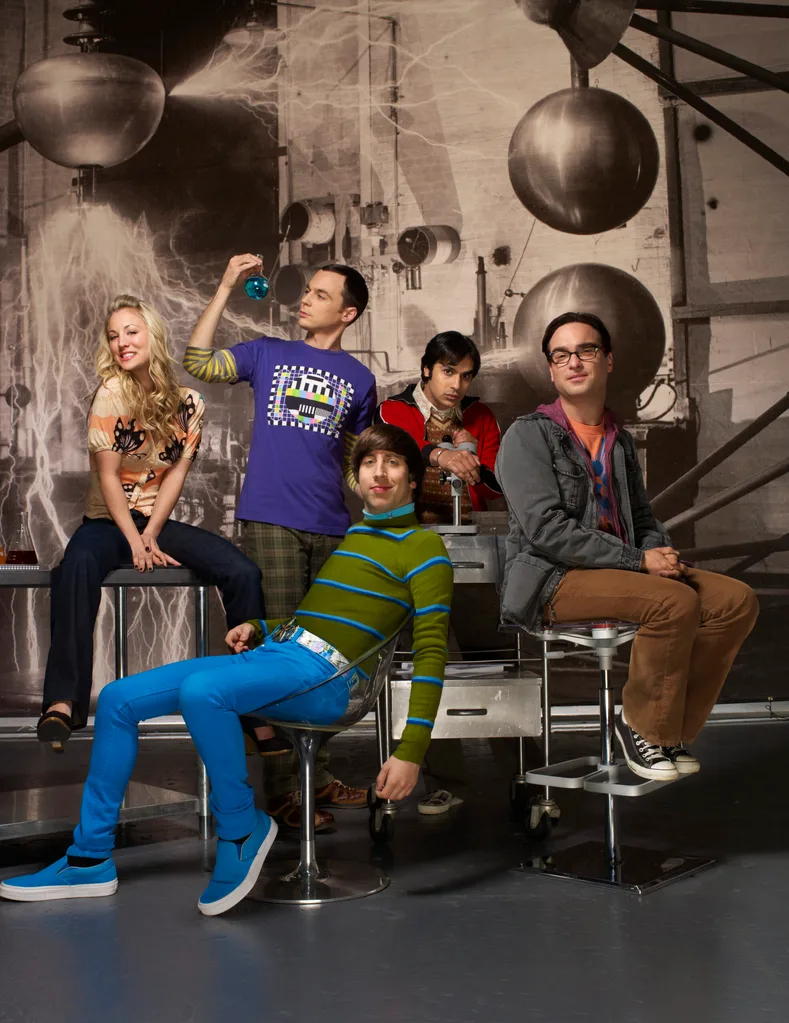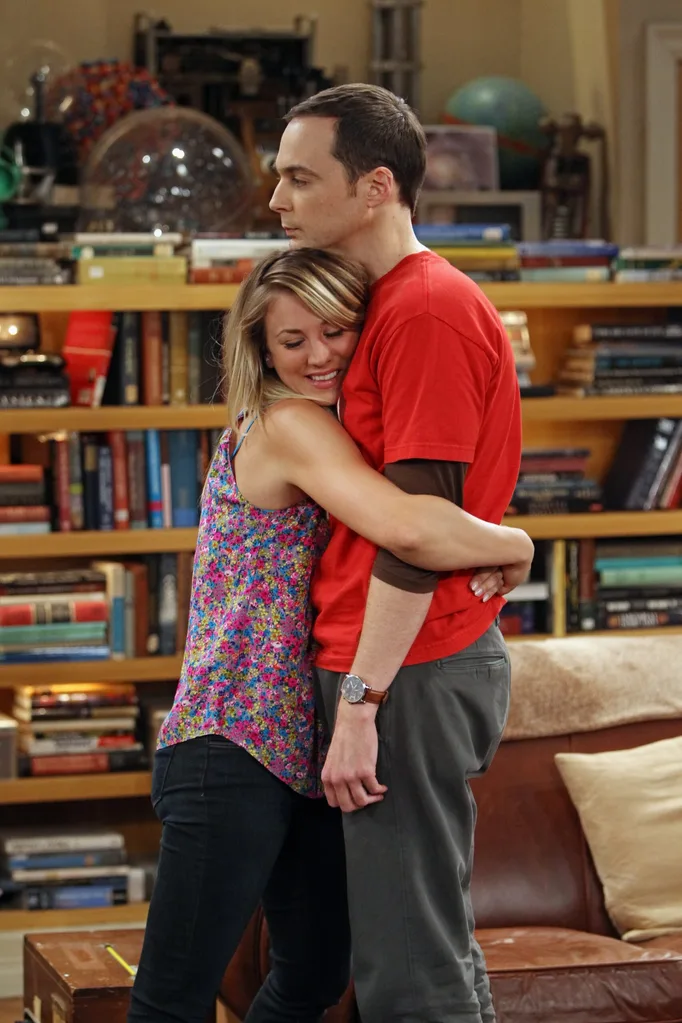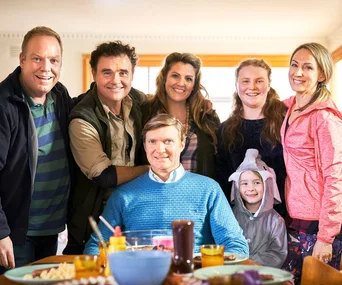In the year of its debut, The Big Bang Theory faced stiff competition.
In 2007, TV was filled with quality programming, including Mad Men, Gossip Girl, Ugly Betty, Californicaton, Summer Heights High, Damages, Pushing Daisies – and the juggernaut that is Keeping Up With The Kardashians kept viewers rapt.
A quirky sitcom about four science nerds and their ditzy neighbour was overshadowed among the on-screen riches of that year. The fact that the “mates in an apartment block” premise was still so fresh in our minds, following the end of the iconic Friends in 2004, also could have cruelled The Big Bang Theory’s chances of success.
The show arrived on Australian screens on December 3, 2007 (after airing in the US that September). It generated lukewarm reviews and average ratings, and hardly seemed likely to become a ratings juggernaut in the ensuing decade.
But The Big Bang Theory was the little show that could – and did.

The Big Bang Theory was the little show that could.
More than a decade on, producers and creators Chuck Lorre and Bill Prady have announced that The Big Bang Theory will conclude at the end of its 12th season in May 2019.
“We, along with the cast, writers and crew, are extremely appreciative of the show’s success and aim to deliver a final season and series finale that will bring it to an epic creative close,” Chuck, 65, said when announcing the news in August.
“We are forever grateful to our fans for their support.”
After 279 episodes (at its end), 10 Emmy award wins (from 52 nominations) and consistently high ratings from its second season onwards – where it regularly ranked as US TV’s No.1 comedy – The Big Bang Theory has opted to go out with a bang rather than a legacy-diminishing whimper.
So why – and how – did a show that debuted so inauspiciously become the longest-running multi-camera TV comedy ever? And how did it become one of the defining TV landmarks of the decade, making single-name stars of its characters – and multimillionaires of the actors who portrayed them?
Attempting to explain the alchemy that makes one show the hit of its era while another disappears without a trace is almost impossible, concede The Big Bang Theory creators.
“We just never wanted to let the audience down,” Chuck tells TV WEEK Close Up. “I’ve always hoped that no matter what show you watched, it was worth watching. At a certain point, you start realising there’s a body of work here and we wanted them all [every episode] to be wonderful.”

The cast are preparing to say goodbye to their beloved show.
Johnny Galecki, 43, who’s played physicist Leonard Hofstadter since the show’s debut, says the unique characters struck a particular chord.
“I think what’s special, and this is something that you can never hope from a television show, is the way it’s changed the social norms on how people look at folks in the sciences and how’s it’s inspired kids,” he says.
Kunal Nayyar, 37, who plays astrophysicist Raj Koothrappali, believes the quality and consistency of the writing has been the foundation of The Big Bang Theory’s success.
“Every Tuesday night, when the script comes in the inbox, I’m always just waiting for it, because it feels like Christmas morning,” he says.
“I’ve always said that one of the greatest things about the show is that the writers have done such a good job with these characters evolving. So to have an ability to explore the character through all the trials and tribulations has been wonderful. It’s not been stagnant.”
Arguably the show’s biggest star, Jim Parsons, who’s made his character Sheldon Cooper one of the great TV creations, has a simple theory.
“As a watcher and lover of TV all my life, it’s been a real honour to have been on something that’s so substantial timeline-wise,” he says.
“To be on TV with just one show as long as we have is, in a historical context, a really exciting thing. I feel we’re fortunate to have been part of a show that’s been slightly bigger than a blip!”

The series will have completed 279 episodes by the end of its final season.
The fact that The Big Bang Theory has never strayed far from tried-and-tested sitcom formulas has also contributed to its success. The chemistry among the actors has been especially important.
“It’s a cast of comedy pros,” Canadian TV critic Jaime Weinman noted in 2014. “Johnny Galecki and Kaley Cuoco were sitcom vets. Jim Parsons became the breakout star. There was no weak link.”
In the US, the growth in The Big Bang Theory‘s ratings followed its move in 2010 to 8pm on Thursday evenings. That timeslot, since The Cosby Show became a huge hit in the 1980s, has traditionally been seen as the “must-see TV” slot. Its family-friendly appeal to a wide demographic made The Big Bang Theory a hit with viewers from eight to 80 too.
Reliable pacing throughout episodes has also ensured that viewers are guaranteed consistent laughs. A New York magazine article in 2014 found The Big Bang Theory offered up a steady 4.3 jokes per minute – and its mentions of real locations, such as The Cheesecake Factory, made it relatable to fans.
But perhaps the cleverest – and simplest – move was to set the action in an apartment block, which also worked so well for Friends, Seinfeld and Will & Grace, among others.
“It gives you that French farce feel,” former Seinfeld producer and writer Peter Mehlman says.
“It eliminates any question in the audiences’ mind about what a character is doing there. These people can just be there all the time. It’s especially great when you need somebody to come in at the exact wrong moment.”
The “will they, won’t they?” relationship trope has been the backbone of The Big Bang Theory’s success too. The early Leonard and Penny (Kaley Cuoco) romance – and their subsequent break-ups and eventual marriage – as well as Sheldon’s relationship with his soulmate and intellectual equal Amy (Mayim Bialik), has kept the audience invested throughout.
That the relationships were rounded out satisfactorily with weddings was celebrated by the fans and cast alike.
“Sheldon has evolved since he’s been with Amy,” Jim, 45, says.
“It’s one of the journeys they [the writers] have really worked to take him on. As an actor, I thank God for it, because moving it along enough to keep everyone interested is a major gift.”

Sheldon was never the emotionally demonstrative type, as Penny seems to be discovering.
The close off-screen bonds the cast share have contributed to the show’s undeniable X factor. In fact, Kaley and Johnny secretly dated for two years in real life before splitting amicably in 2010.
Disputes over pay can bring the downfall of a successful production – or an individual character – but The Big Bang Theory managed to avoid this because the cast banded together to ensure pay parity.
Initially, Jim, Johnny and Kaley were seen as the principal stars and were paid accordingly. By the commencement of the 10th season, Simon Helberg (Howard Wolowitz) and Kunal (Raj) equalled their co-stars’ pay.
But in March 2017, the five took a 10 per cent pay cut (to US$900,000 each per episode) so that Mayim and Melissa Rauch (Bernadette), who’d joined the show in 2010 and 2009 respectively, could significantly increase their earnings (to around $US500,000 per episode).
There is an element of competition among the cast, however – downtime table tennis matches!
“We have three ping-pong tables at work and we have tournaments,” Kaley, 32, explains.
“We stay after work to play! It’s our rabid obsession.”
Jim thinks the different dynamics between the characters, even after all this time, helped keep the show fresh.
“The joy of discovering, and one of the reasons that I think it’s still around, is that you pair these characters together [Penny and Sheldon, for example] and you’re like, ‘Oh, those two flavours taste great together!'” he says.
“And that’s still how it feels when you’re a part of it and it’s working. You’re like, ‘I didn’t know our characters could talk, great!’ It’s still exciting.”
Kaley adds: “That’s what’s been so magical over the years. Any two characters in any room doing anything is great.”
The cast say they all feel “protective” of their alter egos too.

Johnny Galecki and Kaley Cuoco – Leonard and Penny on screen – dated in real life as well.
“There’s a vulnerability to the [male] characters,” Johnny says.
“There’s no malice in them, which is why a lot of the other characters − especially Penny − were difficult to play against. Because if there’s any dynamic of anyone else being manipulative towards these guys, the audience turns on that character immediately.
“It’s very much to Kaley’s credit that she didn’t threaten that. The audience feels protective of them and we feel protective of them too.”
Bringing such a loved show to an end while still at the height of its powers was always going to cause an outcry. But for Jim, who it’s thought drove the decision to end the series after feeling unable to commit to a further two seasons, it was time.
“I will miss all of you, and all of this, more than I can say and more than I can know at this time,” he said in a note on Instagram when the shock announcement was made.
The decision was never going to be taken lightly.
“Everyone understands that you don’t do something like this and not suffer a mourning period about it,” he once said when asked about the show ending in theory.
“Even if you decide it’s the right move, it’s really going to be hard to say that final goodbye. I mean, 12 years, that’s a lot of somebody’s lifetime. I’ve never worked anywhere for 12 years. I don’t know that I’ve lived anywhere for 12 years. There’s no prepping for it [moving on]. I recommend everyone get a good therapist ready.”
But even as the cast and fans prepare for the emotional final episodes, Jim has offered a glimmer of hope for an eventual reboot.
“We’ll see you on Hulu [the streaming TV company] in 2030!” he says with a laugh.
Kaley, who’s admitted she’s “drowning in tears” over the show’s demise is, like its fans, slowly coming to terms with the ending. “I can’t even imagine the last week,” she says.
“But to be able to make people laugh for so many years and have these really sweet storylines and to be this family… it’s hard to talk about, actually. It’s been unbelievable.”

